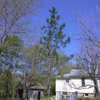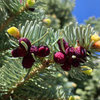Professionalism in the Propagation of Conifers - ACS Reprint
I think many of you, new to conifers or those that have studied them, enjoyed these trees and shrubs, all your life, will enjoy this article. I'm a youngtimer only 32 years old, maybe some of you will remember this.
Professionalism in the Propagation of Conifers
By Edward Remsrola
Reprinted from ACS Bulletin, Summer 1983, Vol.1, No.1
Professionalism implies two major factors: technical excellence and ethics. Historically, technical excellence has been accorded more publicity than ethics. This article will attempt to correct some of this imbalance by discussing the ethics factor. The subject matter is treated in a cursory fashion only with the intent of stimulating more thought and discussion concerning the most important topic.
Specifically, the issues to be examined herein can be grouped into three sections: nomenclature, survivability, and growth habits.
Nomenclature:
The true professional will make every effort to ensure that plants are propagated under correct nomenclature. Through the years, an increasing confusion regarding nomenclature has resulted from a tendency among some plant sources, which are more commercial than ethical, to produce plants incorrectly named. I once purchased Picea abies EchiformisÂ, and Picea abies ÂClanbrassliana which all proved to be Picea abies ÂClanbrasslianaÂ. The name Picea abies ÂPygmaea has been applied to Picea abies ÂHumilis and Picea abies ÂGregorianaÂ. And Picea pungens ÂR.H. Montgomery has been extensively mixed with Picea pungens ÂThumeÂ, ÂGlobosaÂ, ÂCompactaÂ, and ÂHunnewellianaÂ.
Professionalism in certifying the correctness of the nomenclature of the plant being propagated prior to its distribution could result in appreciable progress being made to eliminate these conundrums. Unfortunately, until a distributed reference collection exists of certified conifers, the propagator is left to research this subject on his own. Purchasing plants from reputable sources does, however, minimize the problem to some extent.
Survivability:
Propagating a plant for sale to others carries with it the responsibility to understand the limits of the plants survivability. Although relevant factors are too numerous for the scope of this article, at least a few will be explored.
1. Inherently weak or vulnerable plants:
Here the professional propagator should at least assist a client in ascertaining the probable success to be had when purchasing the plant. For example, if Chamaecyparis lawsoniana ÂLycopoidioides is being sold as a rooted cutting for a container grower, the grower needs to be apprised that significant attrition will result in a wet environment like the Pacific Northwest. Pest problems need to also be considered. For example, mites gravitate to Juniperus x media ÂBlanuw and scale to Tsuga canadensis ÂHussiÂ.
Disease vulnerability is yet another dimension of professionalism. Plants that are easily vulnerable to known disease also need to be qualified to prospective clients.
2. Scion/understock incompatibility:
The long term relationship between a given scion and host understock requires understanding if grafts are to be successful.
Artificial dwarfism may result by certain combinations, such as Pinus parviflora cultivars grafted onto Pinus thunbergii understock. Although not fatal, such a practice should me made known to the purchaser. Other examples can be found in cultivars of Tsuga canadensis, which often demonstrate graft failure, sometimes in plants over ten years old. Such failures may be due to the presence of red and white forms of Tsuga canadensis as proposed by Charles Jenkins and John Swartley. Most Tsuga canadensis variants are thought by some to be the white form while the seedlings used for understock are thought to be of the red form.
The point to be made here is that significant knowledge and research into the compatible combination of scion and understock are required to allow more professionalism to accrue.
3. Hardiness:
When producing grafted conifers, knowledge of the ensuing hardiness of assorted scion/understock combinations should be characterized. Although hardiness is a topic more complex and profound than the highly aggregated zone hardiness guide, the guide should be employed, at a minimum, to determine the hardiness of any combination by representing the least hardy of the two. For example, Picea pungens cultivars may demonstrate poor survivability in extremely harsh Canadian provinces even though the plant is characterized as Zone two. Generally the culprit is the Picea abies or sitchensis understock.
The professional propagator needs to ensure that understock employed is at least as hardy as the scion. Otherwise, the client needs to be apprised if success is to be assured.
Growth Habits:
The mode of propagation may influence the resulting plant to a great extent. Generally, with conifers, plants produced from rooted cuttings have a better chance of retaining the attributes of the parent than those produced by grafting. Two procedures to be followed by the reputable nurseryman when producing rooted cuttings involves the hardening of the young plants to ultraviolet radiation upon their removal from the greenhouse and giving the cuttings sufficient time to produce adequate root systems.
Grafting of conifers involves more than just binding the scion to the understock. Careful scion and cultivar selection must be practiced. Some plants, such as Picea mariana ÂNana show a complete change of character when grafted. Plants which exhibit this behavior should be noted. Likewise, utilization of wood from different parts of a plant may have detrimental effects. Leader wood propagation may produce a sibling of more rapid growth than the parent. Terminal wood propagation is best suited for upright forms, not for globose forms. Side spurs commonly produce prostate plants, especially in the genus Abies, which may eventually throw up a leader and distress its owner.
Pre and post grafting care of the understock is extremely important. The use of unhealthy understock will cause a tendency toward graft failure, as does the use of pot bound material. Many healthy grafts die after a few years in the ground due to root girdling.
Professionalism involves the careful selection of scion wood and the proper care of understock to produce a quality product.
Seedling production results in offspring which are not the same as named cultivars and they should not be treated as such. They need to be identified as seedlings and should be from seed produced by plants growing under conditions as harsh as those of the customer buying the plants.
Many examples exist of plants that have been produced by selection of scion and/or cutting wood that bear little if any resemblance to the parent. The point of professionalism perhaps ought to be to take wood and select understock that optimizes the chance of siblings to be accurate replicas of their nomenclatured parents.
About the author: Ed Remsrola was one of the pseudonyms used by Jean Iseli, see pg. 10.
(pg. 10)
Profile of a Plantsman: Jean Iseli
By Robert L. Fincham
Reprinted from ACS Bulletin, Fall 1986, Vol.4 No.2
Ed Remsrola and Revol Refinoe will no longer be writing articles for the ACS Bulletin. They were pseudonyms for a man who was taken from our ranks much too soon.
Jean Iseli, Charter Member and one of the driving forces behind the development of the ACS, died of an apparent heart attack at his home on June 16, 1986.
Most of our members knew of Jean, and many corresponded with him or had met him personally. Few, however, knew just how important he actually was to the Society. Not one to flaunt his knowledge of conifers and always concerned about a possible "Big Brother" paranoia gripping some of the ACS membership if an owner of Iseli organization appeared to be involved in its organization. Jean only ran for a DirectorÂs seat at my insistence. He authored articles for the Bulletin under assumed names while his energies were otherwise devoted to "behind the scenes" work to further the objectives of the ACS.
-----------------------------------------------------------
"He left the world a little richer and a little betterÂ"
-----------------------------------------------------------
Jean was instrumental in bringing a group of people together at the home of Joel Spingarn for the purpose of forming a conifer society. Jean and I had seriously discussed such a society, via telephone, for many months before the actual gathering. To commence the business meeting, Jean had to present his goals and ideas to everyone. In many ways Jean was a shy, unassuming person, and he abhorred giving any sort of presentation to a group of people. Jean did a very credible job of presenting his ideas, even thought he did try to have me continue the presentation immediately after he stated the purpose for our getting together. When I suggested he continue since he was doing so well, I received one of his "Fincham, you are a real turkey" looks. After the ordeal I could see that Jean was relieved and yet rather pleased with himself for continuing.
Jean was born in La Chausde-Fonds, Switzerland in 1935. When he was seven years old, his family moved to the United States. Upon graduation from Grant High School in Portland, Oregon, Jean attended Reed College for two years and obtained a B.S. in mathematics from Linfield College.
Before discovering the plant world, Jean was a teacherÂs assistant at the University of Washington for two years. He later moved east to become involved with government work as a computer systems programmer and analyst. Jean was always fascinated with art. Besides painting and sculpting on his own, he also aided several art galleries in securing a firm financial footing.
In 1975 Jean and his brother Andre purchased a Boring, Oregon nursery. Jean devoted the last twelve years of his life to making Iseli Nursery the mecca of the conifer world. His original idea of a small nursery which was run by a few people and produced specimen-sized rare conifers proved to be impractical from the beginning. What was essentially a bankrupt operation expanded geometrically into one of the worldÂs largest suppliers of rare and unusual conifers in up to specimen size.
With his flair for words and an innate ability to interact with other plant collectors, Jean was able to amass a world class conifer collection at the nursery. Many people would visit the nursery to see as much of the collection as possible. Most people would visit the nursery to meet Jean. Jean had a reputation as a bit of an eccentric. While demonstrating a brilliant, analytical mind and possessing an extensive, complex vocabulary, he treated shoes as an anathema to be avoided (article continues).








Embothrium
conifersOriginal Author
Related Discussions
Using a greenhouse this time of year?
Q
Rabbits biting off Norway Spruce
Q
Chamaecyparis Obtusa 'Filacoides' Alternatives?
Q
Wabi Sabi takes on Oregon Garden
Q
pineresin
conifersOriginal Author
mckenna
SilverVista
karinl